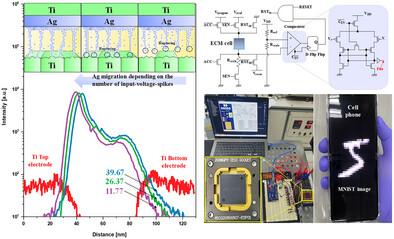Real-Time Unsupervised Learning and Image Recognition via Memristive Neural Integrated Chip Based on Negative Differential Resistance of Electrochemical Metallization Cell Neuron Device
IF 13
2区 材料科学
Q1 CHEMISTRY, MULTIDISCIPLINARY
引用次数: 0
Abstract
Spiking neurons are essential for building energy-efficient biomimetic spatiotemporal systems because they communicate with other neurons using sparse and binary signals. However, the achievable high density of artificial neurons having a capacitor for emulating the integrate function of biological neurons has a limit. Furthermore, a low-voltage operation (<1.0 V) is essential for connecting with modern complementary metal-oxide-semiconductor-field-effect-transistor-based (C-MOSFET—based) integrated circuits. Here, a capacitorless memristive-neural integrated chip (MnIC) based on the negative differential resistance of the electrochemical metallization cell designed using a 28-nm C-MOSFET process in a foundry is reported. The fabricated MnIC exhibits extremely low-voltage operation (<0.7 V) via the rupture dynamics of Ag filaments formed in the GeS2 chalcogenide layer, with a nonlinear increase in the action potential in a manner similar to a human sensory system. Moreover, to construct a fully-structured spiking neural network (SNN), an oxygenated amorphous carbon-based (α-COx-based) synaptic device having 32 multi-level conductance states is designed. The designed MnIC and α-COx-based synaptic device demonstrate real-time unsupervised learning via a spike-timing-dependent plasticity learning rule with an SNN. Using the trained SNN, the real-time hand-written digit image of a cell phone obtained from a live webcam is successfully classified, which suggests practical applications for brain-like neuromorphic chips.

基于电化学金属化细胞神经元负差分电阻的记忆神经集成芯片实时无监督学习与图像识别
尖峰神经元对于构建节能的仿生时空系统至关重要,因为它们使用稀疏和二进制信号与其他神经元进行通信。然而,具有模拟生物神经元积分功能的电容器的人造神经元的高密度可实现性是有限的。此外,低电压操作(<1.0 V)对于连接现代基于互补金属氧化物半导体场效应晶体管(c - mosfet)的集成电路至关重要。本文报道了一种基于电化学金属化电池负差分电阻的无电容记忆神经集成芯片(MnIC),该芯片采用28纳米C-MOSFET工艺在铸造厂设计。制备的MnIC通过在GeS2硫族化物层中形成的Ag细丝的断裂动力学表现出极低的电压(<0.7 V),动作电位以类似于人类感觉系统的方式非线性增加。此外,为了构建全结构尖峰神经网络(SNN),设计了具有32个多级电导状态的氧化非晶碳基(α- cox基)突触器件。所设计的基于MnIC和α- cox的突触装置通过具有SNN的峰值时间依赖的可塑性学习规则实现了实时无监督学习。利用训练后的SNN,成功地对从实时网络摄像头获取的手机实时手写数字图像进行了分类,这为类脑神经形态芯片的实际应用提供了依据。
本文章由计算机程序翻译,如有差异,请以英文原文为准。
求助全文
约1分钟内获得全文
求助全文
来源期刊

Small
工程技术-材料科学:综合
CiteScore
17.70
自引率
3.80%
发文量
1830
审稿时长
2.1 months
期刊介绍:
Small serves as an exceptional platform for both experimental and theoretical studies in fundamental and applied interdisciplinary research at the nano- and microscale. The journal offers a compelling mix of peer-reviewed Research Articles, Reviews, Perspectives, and Comments.
With a remarkable 2022 Journal Impact Factor of 13.3 (Journal Citation Reports from Clarivate Analytics, 2023), Small remains among the top multidisciplinary journals, covering a wide range of topics at the interface of materials science, chemistry, physics, engineering, medicine, and biology.
Small's readership includes biochemists, biologists, biomedical scientists, chemists, engineers, information technologists, materials scientists, physicists, and theoreticians alike.
 求助内容:
求助内容: 应助结果提醒方式:
应助结果提醒方式:


